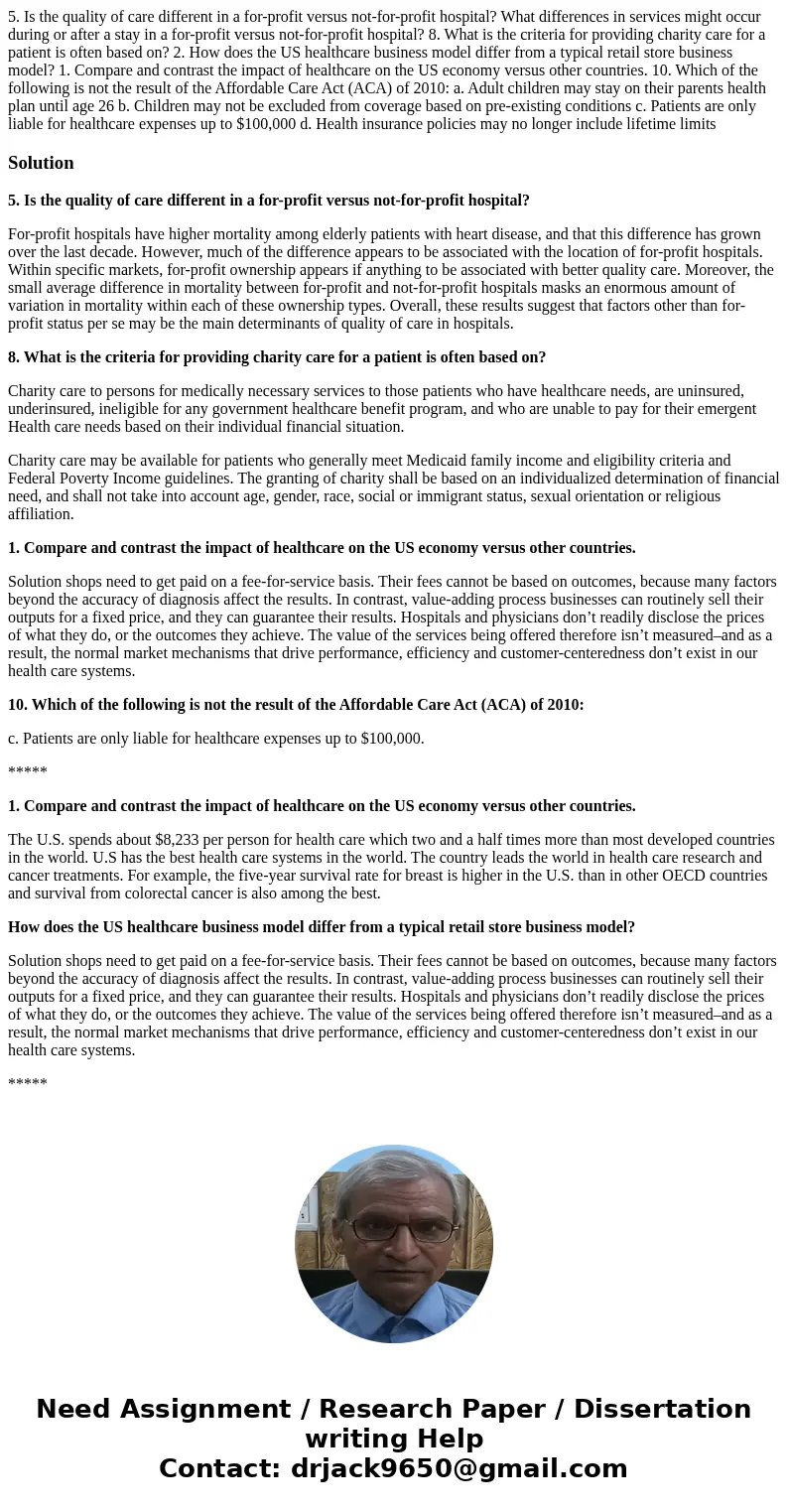5 Is the quality of care different in a forprofit versus not
5. Is the quality of care different in a for-profit versus not-for-profit hospital? What differences in services might occur during or after a stay in a for-profit versus not-for-profit hospital? 8. What is the criteria for providing charity care for a patient is often based on? 2. How does the US healthcare business model differ from a typical retail store business model? 1. Compare and contrast the impact of healthcare on the US economy versus other countries. 10. Which of the following is not the result of the Affordable Care Act (ACA) of 2010: a. Adult children may stay on their parents health plan until age 26 b. Children may not be excluded from coverage based on pre-existing conditions c. Patients are only liable for healthcare expenses up to $100,000 d. Health insurance policies may no longer include lifetime limits
Solution
5. Is the quality of care different in a for-profit versus not-for-profit hospital?
For-profit hospitals have higher mortality among elderly patients with heart disease, and that this difference has grown over the last decade. However, much of the difference appears to be associated with the location of for-profit hospitals. Within specific markets, for-profit ownership appears if anything to be associated with better quality care. Moreover, the small average difference in mortality between for-profit and not-for-profit hospitals masks an enormous amount of variation in mortality within each of these ownership types. Overall, these results suggest that factors other than for-profit status per se may be the main determinants of quality of care in hospitals.
8. What is the criteria for providing charity care for a patient is often based on?
Charity care to persons for medically necessary services to those patients who have healthcare needs, are uninsured, underinsured, ineligible for any government healthcare benefit program, and who are unable to pay for their emergent Health care needs based on their individual financial situation.
Charity care may be available for patients who generally meet Medicaid family income and eligibility criteria and Federal Poverty Income guidelines. The granting of charity shall be based on an individualized determination of financial need, and shall not take into account age, gender, race, social or immigrant status, sexual orientation or religious affiliation.
1. Compare and contrast the impact of healthcare on the US economy versus other countries.
Solution shops need to get paid on a fee-for-service basis. Their fees cannot be based on outcomes, because many factors beyond the accuracy of diagnosis affect the results. In contrast, value-adding process businesses can routinely sell their outputs for a fixed price, and they can guarantee their results. Hospitals and physicians don’t readily disclose the prices of what they do, or the outcomes they achieve. The value of the services being offered therefore isn’t measured–and as a result, the normal market mechanisms that drive performance, efficiency and customer-centeredness don’t exist in our health care systems.
10. Which of the following is not the result of the Affordable Care Act (ACA) of 2010:
c. Patients are only liable for healthcare expenses up to $100,000.
*****
1. Compare and contrast the impact of healthcare on the US economy versus other countries.
The U.S. spends about $8,233 per person for health care which two and a half times more than most developed countries in the world. U.S has the best health care systems in the world. The country leads the world in health care research and cancer treatments. For example, the five-year survival rate for breast is higher in the U.S. than in other OECD countries and survival from colorectal cancer is also among the best.
How does the US healthcare business model differ from a typical retail store business model?
Solution shops need to get paid on a fee-for-service basis. Their fees cannot be based on outcomes, because many factors beyond the accuracy of diagnosis affect the results. In contrast, value-adding process businesses can routinely sell their outputs for a fixed price, and they can guarantee their results. Hospitals and physicians don’t readily disclose the prices of what they do, or the outcomes they achieve. The value of the services being offered therefore isn’t measured–and as a result, the normal market mechanisms that drive performance, efficiency and customer-centeredness don’t exist in our health care systems.
*****

 Homework Sourse
Homework Sourse